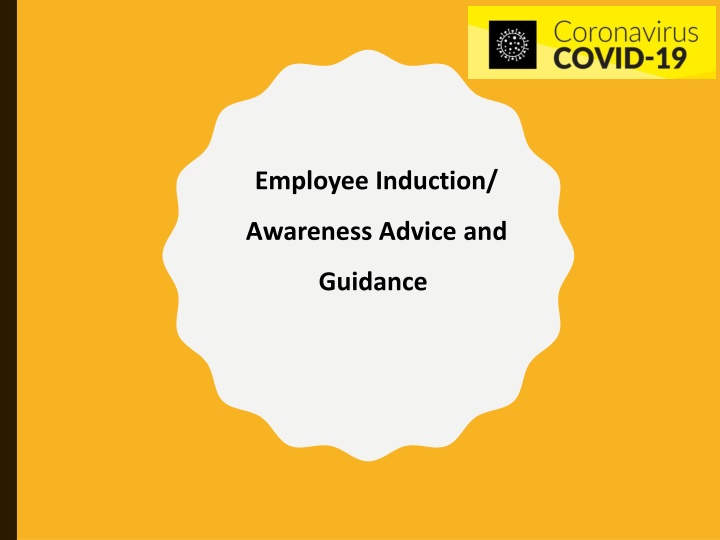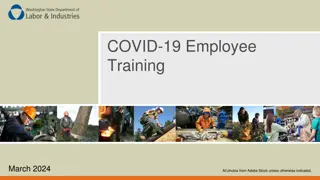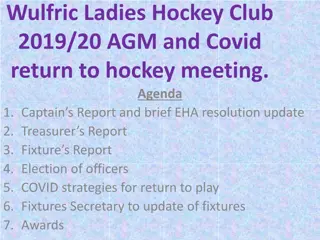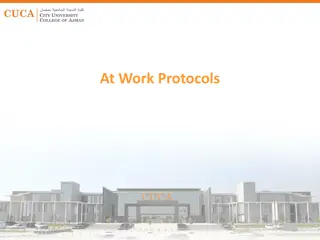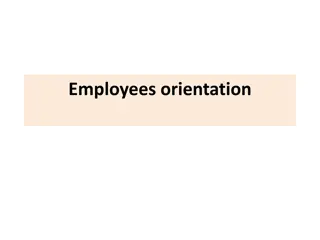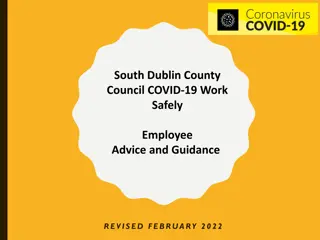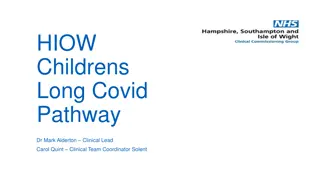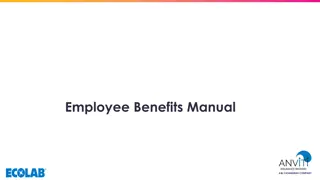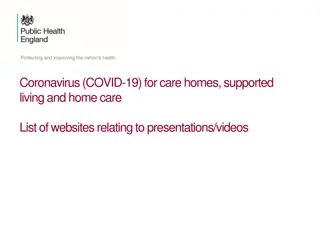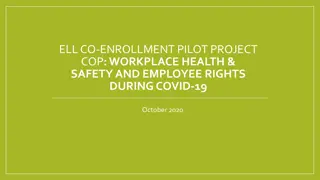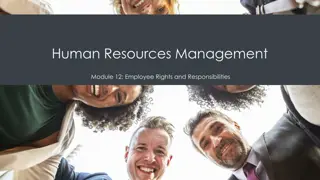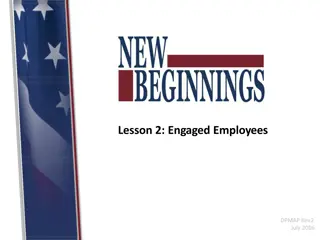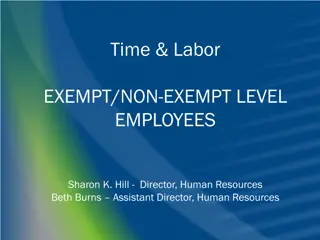Employee Awareness: COVID-19 Guidance and Safety Measures
The COVID-19 pandemic has brought significant impacts to our society and economy. As we gradually reopen our services, it is crucial to follow safety guidelines to suppress the virus spread. This briefing provides essential information on measures implemented by the Council, how to protect oneself and colleagues, and what is expected from all staff members. Understanding COVID-19 symptoms, self-isolation protocols, and close contact guidelines is essential for a safe working environment.
Download Presentation

Please find below an Image/Link to download the presentation.
The content on the website is provided AS IS for your information and personal use only. It may not be sold, licensed, or shared on other websites without obtaining consent from the author.If you encounter any issues during the download, it is possible that the publisher has removed the file from their server.
You are allowed to download the files provided on this website for personal or commercial use, subject to the condition that they are used lawfully. All files are the property of their respective owners.
The content on the website is provided AS IS for your information and personal use only. It may not be sold, licensed, or shared on other websites without obtaining consent from the author.
E N D
Presentation Transcript
Employee Induction/ Awareness Advice and Guidance
INTRODUCTION The COVID-19 pandemic has impacted severely on every part of our society and our economy. Some have been working through this already and as we begin to gradually re-open all of our services in line with the Roadmap for Reopening Society and Business, we need to make sure that we adhere to the rules of this new way of living and working and continue to suppress the spread of the virus. Work is a key part of life and it is important that we can work safely. This Awareness briefing is designed to provide information on the measures implemented by the Council and our responsibilities that will prevent the spread of COVID-19. It aims to inform and advise all staff on how we can protect ourselves and our colleagues against the spread of COVID-19 in the working environment and to ensure your safety and that of our colleagues. We are asking that you to go through this presentation which will inform you how we will operate, what measures have been introduced and most importantly what is expected from you. Please go through this presentation at your own pace and familiarise yourself with the measures required to ensure your safety and that of your colleagues.
CORONAVIRUS (COVID-19) To combat COVID-19, we must understand how it is spread and how to protect ourselves, our families, our colleagues and our community. COVID-19 is a new illness that can affect your lungs and airways. It is caused by a new (novel) virus called Coronavirus. How the virus is spread COVID-19 is spread in sneeze or cough droplets. You could get the virus if you: Come into close contact with someone who has the virus and is coughing or sneezing Touch surfaces that someone who has the virus has coughed and sneezed on and bring your unwashed hands to your face (eyes, nose or mouth) As such we must all follow the public health advice and guidance, as well as any specific measures in place to help prevent the spread of COVID-19 in the work environment.
COVID-19 SYMPTOMS The most common symptoms are: Cough: any kind of cough, usually dry but not always Fever: High Temperature over 38o C Shortness of Breath Difficulty Breathing It can take up to 14 days for symptoms to appear. If you are felling unwell or displaying symptoms, immediately self isolate and make phone contact with your GP and line manager / supervisor. Persons displaying symptoms must telephone their GP and follow advice received.
COVID-19 SYMPTOMS, SELF-ISOLATION AND CLOSE CONTACT To protect you, your colleagues and family, it is essential that if you: 1. Have any symptoms of COVID-19 or if you feel unwell before or during work 0r 2. Have been in close contact with a confirmed COVID-19 case You should immediately self-isolate at home, make phone contact with your GP and line manager / supervisor and follow advice issued.
COVID-19 SYMPTOMS, SELF-ISOLATION AND CLOSE CONTACT Close Contact is defined as: Spending more than 15 minutes within 2 metres of an infected person. Living in the same house or shared accommodation as an infected person. It is advised you do not return to work after isolation unless: It has been 14 days since your first symptoms 5 days have passed without a temperature You have no symptoms Unless your doctor recommends otherwise. If you are in an at risk / vulnerable group, as advised by the HSE, or have any concerns contact your GP.
PROTECTION AGAINST GETTING COVID-19 One of the best ways to prevent person to person spread of respiratory viruses, including COVID-19 is to follow proper hand hygiene and respiratory etiquette.Follow this advice as strictly as possible and encourage others to follow it too. Hand Hygiene - Wash hands regularly and avoid touching your face and eyes with your hands. Use hand sanitiser where soap and water is not available. If hands are visibly dirty, wash hands with soap and water prior to using the sanitiser. Remember this should be for at least 20 seconds. Click Here for Posters & Videos Cough Etiquette - when coughing / sneezing, cover your mouth and nose with your bent elbow or a tissue. Place used tissues into a closed bin and wash hands. Clean and disinfect frequently touched objects and surfaces. Keep your environment clean.
PROTECTION AGAINST GETTING COVID-19 Unnecessary Contact - Do not shake hands or make unnecessary contacts. Physical Distancing - (also known as social distancing) aims, through a variety of means, to decrease or interrupt the spread of COVID-19. It does this by minimising contact between potentially infected individuals and healthy individuals. The current recommended distance to be maintained between people to minimise risk of transmission is 2 metres. If your work activity is going to require close contact within 2 metres, STOP and ask your line manager / supervisor for advice. This will require a risk assessment resulting in additional protection measures.
PROTECTION AGAINST GETTING COVID-19 Physical Distancing - (continued) Recommendations for physical distancing may include: Avoiding any crowded places When in public areas be respectful of the local community. Avoid gathering in groups and follow physical distancing. Organising office space in such a way that physical distances are maintained. Organising teams /crews to consistently work and take breaks together. The teams should be as small as is reasonably practicable in the context of the work to be done. Organising breaks to facilitate maintenance of physical distancing. Conducting meetings using online remote means as much as possible. Where face to face meetings are necessary, the length of the meeting and the numbers attending should be kept to a minimum and participants must maintain physical distancing at all times. Reorganising and rearranging working and break areas e.g. placing tables and chairs far enough apart in canteens. Providing one-way systems for access/egress routes where practicable. Implementing physical distancing during outdoor work activity.
PROTECTION AGAINST GETTING COVID-19 Travelling to work - Where possible, walk or cycle, to and from work. Where possible, travel alone in your private vehicle. Parking arrangements for additional cars and bicycles may need to be considered for employees during this time. If availing of public transport, follow physical distancing guidelines provided by operators. Minimise contact with frequently touched surfaces, e.g. handles, roof straps, isolation bars. Sanitise hands on arrival at work location.
PROTECTION AGAINST GETTING COVID-19 Travelling for work and mobile plant - The occupancy level of vehicles is to be minimised and single occupancy for vehicles is preferable. If more than one per person per vehicle, the following measures should be followed: Sit as far apart as the vehicle allows. Passenger to travel in the back of the vehicle at left passenger side. Keep windows of vehicles open, at least partially. Practice good respiratory hygiene. Key touch points in vehicles / mobile plant are to be wiped regularly (e.g. door handles, steering wheel, handbrake, gear stick, radio controls). Hand Hygiene - hands sanitised before and after entering / exiting the vehicle. Hygienic wipes and hand sanitiser must be available for this purpose. Cough Etiquette - when coughing / sneezing, cover your mouth and nose with your bent elbow or a tissue.
PROTECTION AGAINST GETTING COVID-19 Welfare Facilities - When using welfare facilities such as canteen, toilets, drying rooms allow appropriate time and space to facilitate the correct levels of hygiene and physical distancing. Be respectful of these boundaries. Toilets: You must respect the space available to ensure physical distancing. This may require a longer wait. Canteen: Break times should be staggered to reduce congestion and contact Cleaning materials will be provided, please clean area when finished break/s and dispose of rubbish appropriately Do not share objects that touch your mouth e.g. bottles, cups Always be vigilant of sources of contamination. Drying Rooms: You must respect the space available to ensure physical distancing while you change. Report any concerns to the line manager or supervisor.
PROTECTION AGAINST GETTING COVID-19 Work Environment - We must all work as a team. Throughout your day you should: Continue to maintain hygiene by washing your hands regularly. Keep your workspace clean and disinfected. Regularly clean high touch surfaces e.g. Handrails, Tables, desks, chairs, doorknobs, light switches, handles, phones, keyboards, toilets, taps and sinks. Be mindful of distractions. Equipment, tools and plant - Equipment, tools and plant should not be shared where possible. Keep equipment, tools and plant clean and don t share unless sanitised. Keep hands sanitised before and after use.
PROTECTION AGAINST GETTING COVID-19 When going home - When going home: PPE must remain at the depot / drying room / store. It is recommended that clothes are washed daily. Wash your hands before you leave. Travel alone if possible by walking, cycling, using a private vehicle. If availing of public transport, follow physical distancing guidelines provided by operators. Minimise contact with frequently touched surfaces, e.g. handles, roof straps, isolation bars. Keep contact points on your vehicle clean. Wash your hands when you return home, change your clothes and leave your boots outside.
WORK PROCESSES AND RISK ASSESSMENT All work processes will have to be risk assessed, this process has been designed to protect you and your colleagues. If you are in any doubt speak to your line manager / supervisor for guidance.
GENERAL PRINCIPLE TO BE APPLIED DURING COVID-19 Reduce - the number of persons in any work area to comply with the 2-metre physical distancing guideline recommended by the HSE. Review - work practices, mindful of close working arrangements. Employees should be encouraged to self-assess their task for physical distancing and transmission points. Supervise monitoring compliance to ensure physical distancing, hygiene rules and COVID 19 control measures are being adhered to and maintained in order to reduce the risk of the spread of COVID-19.
HEALTH AND SAFETY DOCUMENTATION Kilkenny County Council has a Covid 19 Working Safely Response Plan detailing how we are implementing the Government Return to Work Safely Protocol. This takes account of: High Level LA COVID-19 Work Safely Health and Safety Guidance (LGMA) Posters/ Videos Risk Assessments Safe Operating Procedures (SOPs) Memos The risk assessment is the most important process for ensuring specific requirements have been assessed AND identified for YOUR workplace/ work activity and are put in place. Each Line Manager should go through their Covid 19 risk assessment and any relevant SOPs with their staff It is important to note that all existing Health and Safety provisions continue to apply during this time.
COMPLIANCE AND MONITORING Monitoring compliance will require ensuring that physical distancing, hygiene rules and COVID 19 control measures are being adhered to and maintained in order to reduce the risk of the spread of COVID-19. It is important to note that compliance with COVID-19 control measures is the responsibility of everyone and must be supported by all in order to protect health and reduce the spread of COVID-19. Compliance checks with COVID-19 may include checking the following measures are in place and being adhered to: Adequate signage Physical Distancing Hand Washing Cough/Sneeze Etiquette Safety Documentation Correct use and disposal of PPE Risk Assessment Increased cleaning regimes where required Staggering breaks, lunch times, etc
WELLBEING Infectious disease outbreaks like coronavirus (COVID-19), can be worrying and can affect your mental health. As well as the Employee Assistance Programme, there are many public resources available which can be accessed at the links below: Minding your Mental Health https://www2.hse.ie/wellbeing/mental-health/minding-your-mental-health- during-the-coronavirus-outbreak.html https://www.gov.ie/en/campaigns/together/?referrer=/together/ Mental Health Supports & Services https://www.hse.ie/eng/services/list/4/mental-health-services/connecting- for-life/news/supports-and-services-during-covid-19.html In This Together Help & Advice to Protect your Mental Health https://www.gov.ie/en/campaigns/together/?referrer=/together/
PEOPLE TO CONTACT IN KILKENNY COUNTY COUNCIL FOR COVID-19 ISSUES We are here to help and advise with physical distancing and hygiene maintenance during this period. Contact any of the following for advice and guidance: Line Manager Health and Safety Officer Covid 19 Compliance Officer Safety Representative HR Officer Your local trade union reps
FINAL NOTE We must all depend on each other to protect ourselves, our families, our colleagues and our community. It is essential that we follow the Government and HSE guidelines at home and at work. Take ownership of yours and others safety Maintain physical distancing Limit physical contact Wash your hands and practice good respiratory etiquette If in doubt STOP and ask your line manager / supervisor THANK YOU
